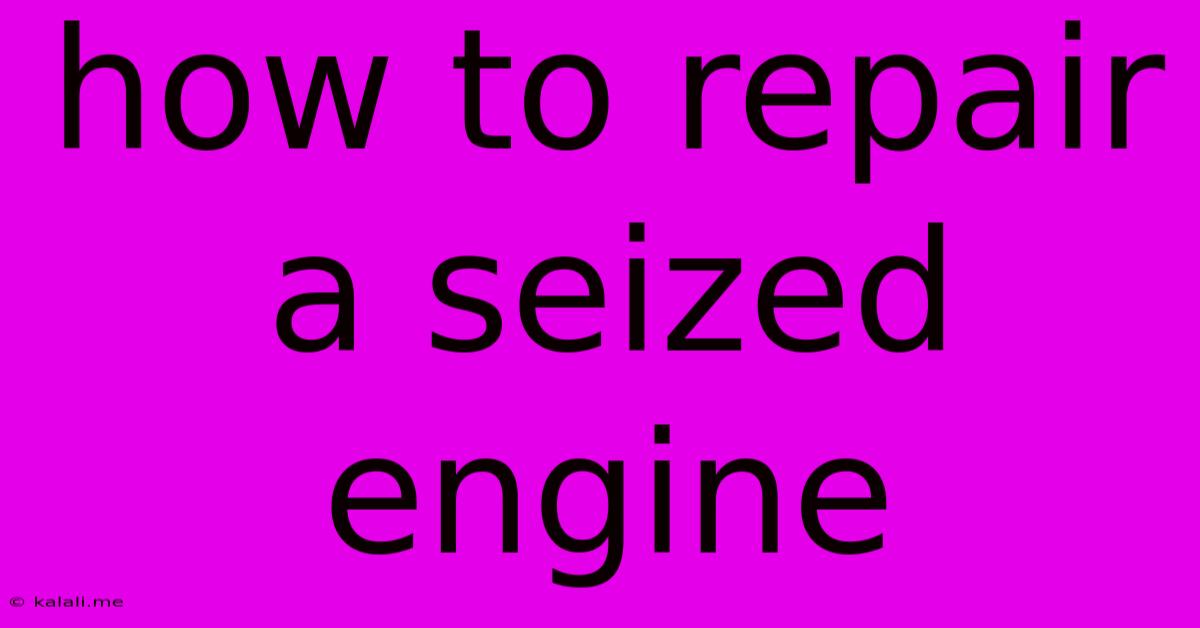How To Repair A Seized Engine
Kalali
May 25, 2025 · 4 min read

Table of Contents
How to Repair a Seized Engine: A Comprehensive Guide
A seized engine is a car owner's worst nightmare. This comprehensive guide explores the causes of engine seizure, the diagnostic process, and the steps involved in repair or replacement. Understanding the complexity of this issue empowers you to make informed decisions about the best course of action for your vehicle.
What is a Seized Engine?
A seized engine occurs when the internal components, typically the pistons, become immobile due to friction and overheating. This prevents the engine from rotating, resulting in a complete loss of power. The damage can range from minor scoring to catastrophic failure, requiring extensive repairs or even a complete engine replacement.
Causes of Engine Seizure:
Several factors can contribute to engine seizure:
- Lack of Lubrication: This is the most common cause. Insufficient engine oil, low oil pressure, or using the wrong type of oil can lead to metal-on-metal contact, causing friction and seizing. Regular oil changes with the correct grade oil are crucial for preventing this.
- Overheating: High engine temperatures can cause the oil to break down, losing its lubricating properties. A malfunctioning cooling system, like a failing thermostat or water pump, can easily lead to overheating and subsequent seizure.
- Foreign Material in the Engine: Debris, such as pieces of broken piston rings or excessive dirt, can interfere with the engine's internal workings and cause seizing. This can often result from neglecting routine maintenance.
- Improper Engine Break-in: For new engines, improper break-in procedures can lead to premature wear and tear, increasing the risk of seizure. Following the manufacturer's recommendations is vital.
Diagnosing a Seized Engine:
Before attempting any repairs, accurately diagnosing the problem is critical. Here are some tell-tale signs:
- Inability to start: The engine cranks but doesn't turn over.
- Unusual noises: Grinding, knocking, or other unusual sounds from the engine compartment may indicate significant internal damage.
- Overheating: Persistent overheating is a strong indicator that something is seriously wrong with your engine.
- Smoke from the exhaust: Excessive smoke, particularly blue or white smoke, can suggest internal damage.
Repairing a Seized Engine: A Step-by-Step Guide (General Overview)
Repairing a seized engine is a complex and time-consuming process, often requiring specialized tools and expertise. The exact procedure varies greatly depending on the extent of the damage. It is highly recommended to seek professional help unless you have significant mechanical experience. This guide provides a general overview:
-
Inspection and Assessment: A thorough visual inspection is necessary to assess the damage. This may involve removing components to determine the extent of wear on the pistons, cylinders, and connecting rods. Specialized tools like a borescope may be needed for a precise diagnosis.
-
Disassembly: If repair is deemed feasible, the engine must be disassembled. This involves removing various parts, including the cylinder head, crankshaft, pistons, and connecting rods.
-
Repair or Replacement: Damaged parts must be either repaired (if possible) or replaced with new or reconditioned components. This often involves honing or sleeving the cylinders, replacing piston rings, bearings, and potentially the entire crankshaft.
-
Reassembly: Once all components are inspected, repaired, or replaced, the engine is meticulously reassembled, paying close attention to proper torque specifications and alignment.
-
Testing and Inspection: After reassembly, the engine needs thorough testing to ensure proper functionality and identify any lingering issues.
When to Replace Instead of Repair:
Repairing a seized engine can be costly and time-consuming. Consider replacing the engine entirely if:
- The damage is too extensive for cost-effective repair.
- Repair costs exceed the value of the vehicle.
- You lack the necessary skills and tools to undertake the repair.
Prevention is Key:
Preventing a seized engine is far more efficient than repairing one. Follow these preventative measures:
- Regular oil changes: Use the correct type and grade of oil recommended by the manufacturer.
- Maintain proper coolant levels: Regularly check and top off your coolant as needed.
- Address overheating promptly: Don't ignore overheating warning signs.
- Regular vehicle maintenance: Follow your manufacturer's recommended maintenance schedule.
Repairing a seized engine is a challenging endeavor, best left to experienced mechanics. While this article offers a general understanding of the process, professional assistance is strongly recommended to ensure proper repair and avoid further damage. Prioritizing preventative maintenance is the most effective way to avoid this costly and frustrating issue.
Latest Posts
Latest Posts
-
The Client Is Not Connected To An Analysis Server
May 25, 2025
-
Why Do Planes Fly So High
May 25, 2025
-
How To Identify If A Chair Is Cis Or Trans
May 25, 2025
-
Wiring A Three Way Switch With A Dimmer
May 25, 2025
-
Stephen Shrees Volumes On Discrete And Continuous Time Models
May 25, 2025
Related Post
Thank you for visiting our website which covers about How To Repair A Seized Engine . We hope the information provided has been useful to you. Feel free to contact us if you have any questions or need further assistance. See you next time and don't miss to bookmark.